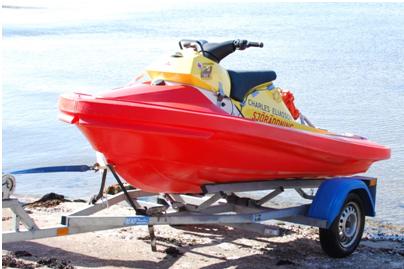
Rescuerunner fire extinguisher
A device that easily can be connected to the rescuerunners water jet.
Problem/Background
The background of this project is a cooperation between the Swedish Sea Rescue Society and design students at Chalmers University of Technology with a goal to generate a concept to improve existing technology in firefighting and bilge pumping at sea. Question formulations that have been discussed in this report are: How can fire fighting and bilge pumping at sea be simplified? and How can the water jet of a Rescuerunner be used in firefighting and bilge pumping? The developmental process has followed a design- and product development methodology and resulted in a final concept.
Interviews and study visits have been done to analyze how fires at sea are currently extinguished and a function analysis and specification of requirements have been the basis for the choice of a final concept.
During the idea generation phase different methods have been used, such as de Bonos Thinking Hats, idea shifting and brainstorming, in order to generate as many solutions as possible. All the documents have been open and were expanded during the project when iteration loops were performed.
The different functions that were generated were later weighed against each other in an elimination matrix and lastly the final concept was compared to the specification of requirements to ensure that all criteria were met.
Result/Solution
The concept consists of a solid tube that forms the shape of an L. At the lower end of the tube you will find a link which, with small modifications to the exhaust nozzle on the jetski, can easily be mounted. When you connect the pipe, you must first hone in and meet the nozzle under the water and then with a simple twist lock the connection. This coupling uses the water pressure from the jet to further lock it and thus minimize the risk for the coupling to come loose.
To simplify the alignment of the nozzle under the water, the coupling is shaped as a cone and there are guidelines and arrows both on the jetski and the tube. The wet environment which the product should be used in put great demands on the grip, why rubber strips are placed along the tube. This concept is thus designed so that it can be easily operated by one person, and users do not need to jump into the water to turn on the device and lose valuable time.
At the other end of the tube, above the water surface, there is a so-called normal coupling. A normal coupling is a kind of standard connection for hoses of higher dimensions. This connection helps to further broaden the application.
The benefit is that this concept is compatible with all of today’s fire-fighting equipment that uses water. If you want to put out a smaller fire on a boat, you put on a smaller hose. Would you rather put out a fire in a lake house, you can connect hoses of larger dimension, and branch these into smaller hoses for effective extinguishing. The standard model does, however, bring a small tube with a handy spray nozzle, because it is primarily one person who mans the jetski.
This entire kit, pipe hose and nozzle is packaged in a waterproof box that is attached with two snap hooks on the back of the rear deck while driving. Another important aspect is to prevent the device to sink when dropped in water. Therefore, there is a safety line which is connected between the tube and the box.
Who is behind the project?
•  Group of 4 student from Chalmers University of technology at the age between 21-27
•  First year at the Design engineering program
•  5 week group project in design methodology.
Contact
If you have any questions about this project, you can send the project owner a message from here.
Comments
Share your thoughts about this project and let the project team know what you think. Comments are moderated to make sure a friendly and nice tone are kept by all.